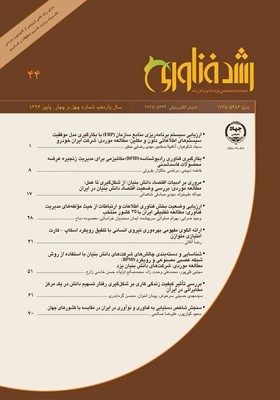سنجش شاخص دستيابي به فناوري و نوآوري در ايران در مقايسه با کشورهاي جهان
محورهای موضوعی : مديريت تکنولوژي
سعید کیان پور
1
![]() ,
علیرضا صالحی
2
,
علیرضا صالحی
2
1 - پیام نور
2 - پیام نور
کلید واژه: فناوري, نوآوري, کسب و کار, شاخص ترکيبي, مهارت انساني,
چکیده مقاله :
بررسيها نشان ميدهد که فعاليتهاي مربوط به توسعه فناوري و نوآوري، به عنوان پيشرانهاي اصلي رشد اقتصادي محسوب ميشود. هدف از اين مقاله معرفي شاخص جهاني نوآوري (GII) و شاخص دستيابي به فناوري (TAI) و بررسي وضعيت ايران در اين شاخصهاست. در شاخص جهاني نوآوري، کشورمان در سال 2014، رتبه 120 را کسب کرده است. آنچه از مطالعه گزارشهاي پيشين شاخص جهاني نوآوري به دست ميآيد نشان ميدهد که کشورمان نتوانسته جايگاه خود را حفظ يا بهبود بخشد. شاخص جهاني نوآوري از ترکيب 21 متغير اصلي تشکيل شده است که کشورمان در متغيرهاي آموزش عالي، تحقيق و توسعه، خلق دانش و زيرساخت عمومي از وضعيت بهتري نسبت به ساير متغيرها برخوردار است. در متغيرهاي محيط سياسي، تجارب و رقابت، انتشار دانش و آثار دانش، کمترين امتياز را در بين ساير متغيرها کسب کرده است. به عبارت ديگر، کشورمان در ارکان ورودي خصوصاً در بخش آموزش عالي از جايگاه نسبتاً خوبي برخوردار است اما در ارکان خروجي وضعيت مطلوبي ندارد. شاخص ديگر شاخص دستيابي به فناوري است، اين شاخص شامل ايجاد فناوري جديد، انتشار نوآوريهاي جديد، انتشار نوآوريهاي قديمي و مهارتهاي انساني است که در اين شاخص در گروه کشورهاي متوسط قرار گرفتهايم. مطالعه شاخصهاي ترکيبي نشان ميدهد سياستگذاران بايد توجه بيشتري براي بهبود شرايط نوآوري داشته باشند تا يافتههاي علمي و نتايج تحقيقات و نوآوري و خلق ثروت براي اجتماع ايجاد شود.
S tudies show that activities related to technology development and innovation are the main factors of economic growth. The purpose of this article is to introduce the Global Innovation Index (GII) and technology achievement index (TAI) and to evaluate Iran in these indicators. Our country has earned 120 through GII ranking in 2014. Previous studies reported of global innovation index show that our country has not been able to improve its position. Global Innovation Index is made up of 21 main variables that our country in the variable of higher education, research and development, knowledge creation and public infrastructure is better than other variables. It earned the lowest score In variables of political environment, experience and competitive, knowledge dissemination and knowledge in comparison with other variables. It means our country has good position in Input Components especially in high education but in Components of output has not good condition. Another indicator is access to technology; this index includes the creation of new technologies, release new innovations, diffusion of old innovations and human skills that in this indicator are member of intermediate these countries. Studying Composite indicators show that policymakers should pay more attention to improve innovations until creation results of research and innovation for community.
1- شاهآبادي، ابوالفضل، اثر حقوق مالکيت معنوي بر توزيع درآمد در کشورهاي منطقه منا، فصلنامه رشد فناوري، سال هفتم، شماره 28،1390.#
2- کيانپور، سعيد، تولايي، رويا، سنجش و بهبود محيط کسب و کار، چاپ اول، انتشارات فراگير هگمتانه،1392.#
3- کيانپور، سعيد، توسعه اقتصادي و برنامهريزي (رويکرد محيط کسب و کار)، انتشارات فراگير هگمتانه، چاپ اول، 1392.#
4- عليزاده، پريسا. «سنجش علم و فناوري (1): نظام سنجش علم و فناوري در ايران» مرکز پژوهشهاي مجلس شوراي اسلامي، 1389.#
5- کيانپور،سعيد، بررسي شاخص بينالمللي حقوق مالکيت در ايران و کشورهاي منطقه منا، فصلنامه رشد فناوري، سال يازدهم، شماره 41 ،1393.#
6- زينالعابديني،اکبر، بررسي وضعيت شاخصهاي ترکيبي فناوري و نوآوري در ايران، مرکز پژوهشهاي مجلس شوراي اسلامي، 1394.#
7- Groeneveld, R. A. and G. Meeden. ‘Measuring Skewness and Kurtosis’. The Statistician 33:391–99, 1984.#
8- Saisana, Michaela and Dionisis Th. Philippas. Joint Research Centre Statistical Audit of the 2013 Global Innovation Index, Annex 3 to Chapter 1, The Global Innovation Index 2013 (PDF). Ispra, Italy: INSEAD, Cornell University, WIPO. pp. 55–67. ISBN 978-2-9522210-2-3, 2013.#
9- Franklin, M. and Mistry, P. , Quality-adjusted Labour Input: Estimates to 2011 and First Estimates to 2012, http://www.ons.gov.uk/ons/dcp171766_317119.pdf, 2013.#
10- Gudyanga F., Science, Technology and Innovation (STI) in supporting Africa`s industrial Development, Second Meeting of the Committee on Development Information, Science & Technology (CODIST-II)Addis Ababa, Ethopia 02-05 May 2011.#
11- Oulton, N. and Wallis G. "An Integrated Set of Estimates of Capital Stocks and Services for the United Kingdom: 19501-2013” Paper for the 33rd General Conference of the IARIW, Rotterdam, August 24-30, 2014.#
12- Wallis, G. “Essays in Understanding Investment”. http://discovery.ucl.ac.uk/1369637/1/GW_Thesis.pdf, 2012.#
13- Goodridge, P., Haskel, J. and Wallis, G. “Can intangible investment explain the UK productivity puzzle?”, National Institute Economic Review, No, 224, May 2013.#
14- Goodridge, P., Haskel, J. and Wallis, G. “The Contribution of the Internet and Telecommunications Capital to UK Market Sector Growth”, available on request, 2012.#
15- Paruolo P., M. Saisana, and A. Saltelli. ‘Ratings and Rankings: Voodoo or Science?’ Journal of the Royal Statistical Society A 176(2), doi: 0964–1998/13/176000, 2013.#
16- Cornell University, INSEAD, and WIPO (2014) The Global Innovation index (2013): The Local Dynamics of Innovation, Geneva, Ithaca, and Fontainebleau, 2013.#
17- Cornell University, INSEAD, and WIPO(2014) The Global Innovation Index (2014): The Human Factor In innovation, second printing. Fontainebleau, Ithaca, and Geneva, 2014.#
18- INSEAD and WIPO, 2012, The Global Innovation Index 2012: Stronger Innovation Linkages for Global Growth, ISBN:978-2-9522210-2-3 Printed and bound in France by INSEAD, Fontainebleau, 2012.#
19- INSEAD 2011, the Global Innovation Index 2011: Accelerating Growth and Development, ISBN: 978-2-95222210-1-6,2011.#


